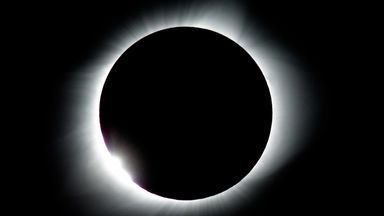Total Solar Eclipses—in which the sun is blocked from view by the moon—are precious events. After Monday's spectacular, the next worldwide occurrence will not be until late 2026, and the US will not glimpse another until late 2044.
Scientists with the European Space Agency (ESA) don't want to wait, however, and so have come up with a way to make their very own eclipses on a nearly daily basis.
The trick is that they won't be waiting for the moon to be in just the right place, but will use one spacecraft with a round shield to cast a shadow over the special censors of a second craft.
By blocking out the main body of the sun just like in a moon-caused eclipse, researchers will be able to study its surrounding atmosphere, the so-called "solar corona", which is normally drowned out by the sheer glare of the star.
A million degrees hotter than the surface of the sun beneath it, the corona is important to us because it is the source of the solar wind, space weather, and violent eruptions known as "coronal mass ejections" that have the power to disrupt communications, electronics and power here on Earth.
After launching from India this September and traveling into orbit around the Earth, the two craft will separate to a distance of around 492 feet.
Then, lining up with the sun via incredible precision spaceflight, the so-called Occulter satellite will cast its shadow onto the face of the Coronagraph satellite, allowing it to measure the sun's atmosphere at a distance of 1.1–3 solar radii from the star.
"The two spacecraft will act as if they are one enormous 150 meter-long instrument," said the ESA's Director of Technology, Engineering and Quality, Dietmar Pilz.
He added: "Achieving this will be extremely technically challenging, however, because the tiniest bit of misalignment and it won't work.
"The development process has been correspondingly long, undertaken by a consortium of smaller ESA Member States led by Spain and Belgium.
"So I am very pleased to see Proba-3 here today, being prepared for launch."
Both ground- and space-based telescopes can be fitted with so-called "occulting disks" that, standing in place of the moon, block out the un to mimic the effect of an eclipse.
This technique is limited, however, by diffraction—a phenomenon that causes light to leak over the edges of the discs, spoiling the resulting image of the sun's corona.
The solution to this is to move the occulting disk further away from the recording instrument. By using two spacecraft, a greater separation (and thus a better image) is made practical.
The other advantage of creating artificial eclipses in space is that, through careful maneuvering of the two satellites, they can be made to last much longer than their natural counterparts.
Next week's eclipse will, at the most, last about four-and-half minutes for viewers in the US.
In contrast, Proba-3 will be able to create events lasting up to six hours at a time. These will occur automatically once every 19 hour and 36 minutes, when the craft reach the 'top' of their highly elliptical orbit, which reaches a distance of 37,610 miles from Earth's surface.
At this distance, the ESA explains, atmospheric, gravitational and magnetic disturbances from our world are minimized, allowing for clearer measurements of the sun's corona.
The ESA unveiled both Proba-3 craft this week at the Redwire Space Facility in Kruibeke, Belgium, where they are presently undergoing pre-flight testing.
However, members of the mission team will be taking advantage of Monday's total solar eclipse over the US to test out pieces of hardware designed for the spacecraft.
These include polarizing filter wheels destined for use in the Coronagraph satellite, alongside alternative LED technology.
These tests will join various other experiments studying Monday's event—including NASA efforts to both "chase" the eclipse with jet planes, and probe its effect on the upper atmosphere using special rockets.
Have scientists arranged eclipses before?
The fundamental idea of creating arranged eclipses using spacecraft isn't actually a new one.
Back in 1975, "Apollo–Soyuz Test Project" entered the record books as the first international crewed space mission.
The joint spaceflight saw an American Apollo spacecraft dock with a Russian Soyuz capsule, a symbol of the detente between the Cold War powers.
Various experiments were undertaken during the mission—and one involved the craft temporarily undocking so that the Apollo craft might cast its shadow onto the Soyuz capsule, allowing the Russian cosmonauts to photograph the sun.
While this worked, it was a one-off event. In contrast, the Proba-3 mission will not only provide arranged eclipses daily, and with far more precise shadow-casting.
Alongside allowing a fresh view at the sun's corona, the Proba-3 mission will also be a proof-of-concept for a new level of precision formation flying—brought down to millimeter-level accuracy thanks to a combination of positioning technologies.
These will include satellite navigation, radio-based links, visible light cameras that hone in on positioning LEDs and even a laser beam reflected back-and-forth between the two craft.
According to the ESA, Demonstrating such precise spaceflight will "enable a whole new era for science and applications".
"Missions could be flown that are much larger than any single spacecraft—such as giant in-orbit radio and optical interferometry arrays."
(These would use individual craft to create a "single" telescope far more powerful than each of its individual parts.)
At the same time, the agency said, "precise orbital rendezvous would make in-orbit satellite servicing feasible, extending the life of space infrastructure."
Do you have a tip on a science story that Newsweek should be covering? Do you have a question about eclipses? Let us know via science@newsweek.com.
Disclaimer: The copyright of this article belongs to the original author. Reposting this article is solely for the purpose of information dissemination and does not constitute any investment advice. If there is any infringement, please contact us immediately. We will make corrections or deletions as necessary. Thank you.



